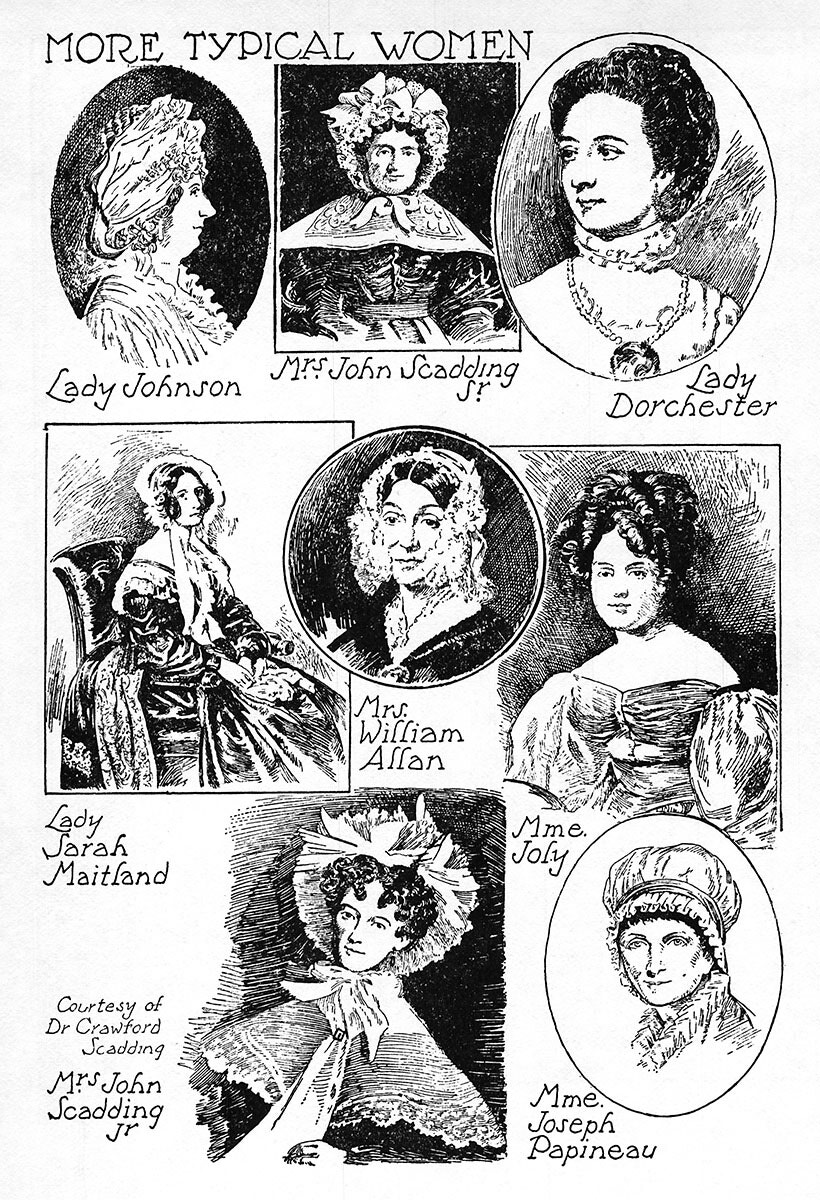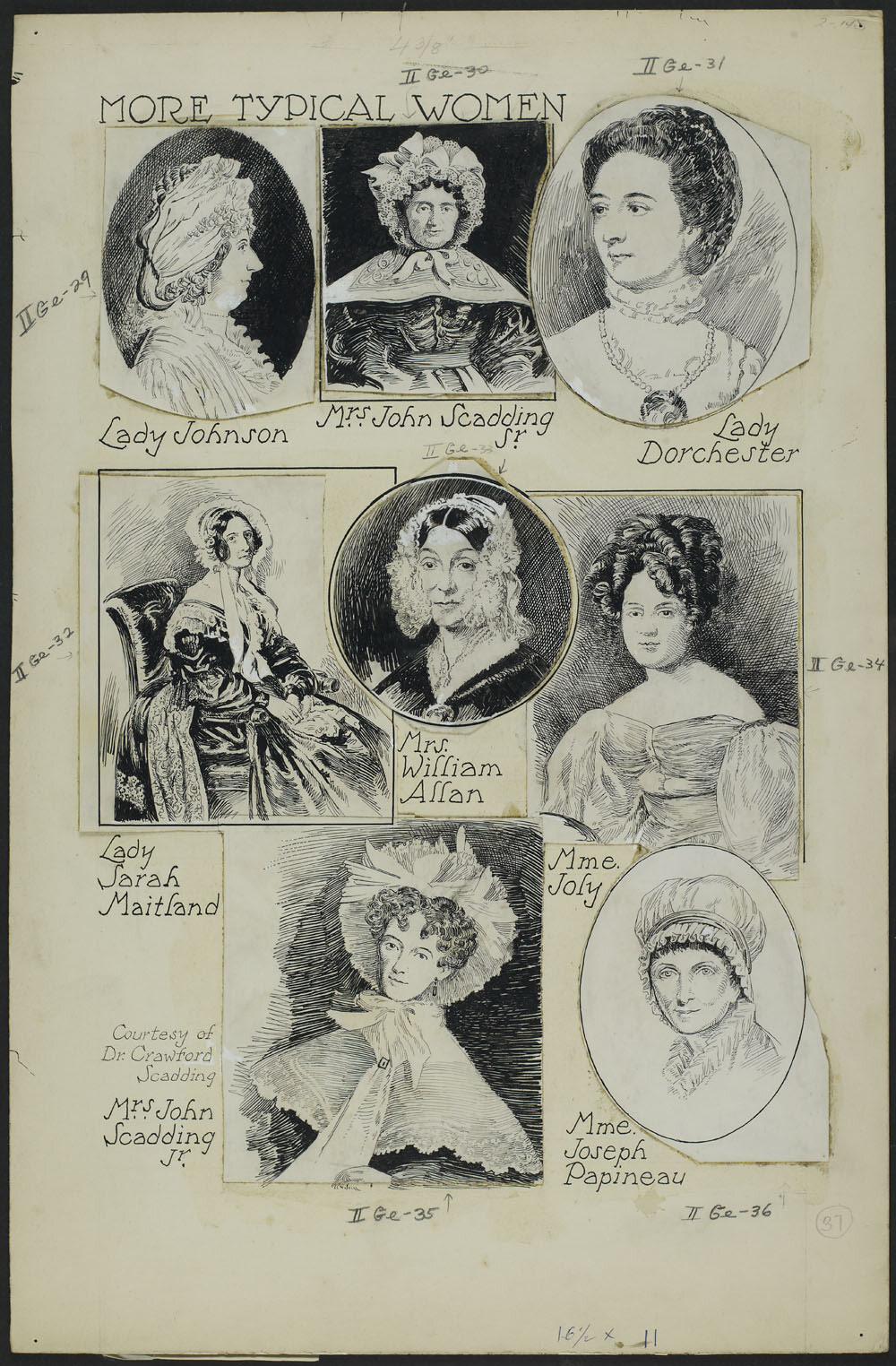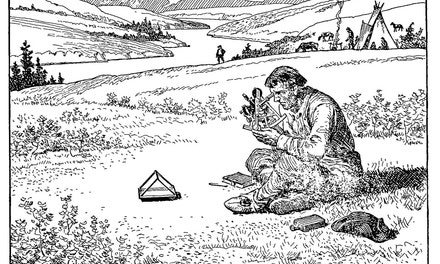More Typical Women
Library and Archives Canada, Acc. No. 1972-26-217
Remarks
C.W. Jefferys' notes about this picture from The Picture Gallery of Canadian History Volume 2
These pages have been designed to illustrate not only characteristic women of the time, but also to show styles of hairdressing and costume.
Mary Watts, of a distinguished New York family, married, 1773, Sir John Johnson, son of Sir William Johnson. Her husband succeeded his father as Superintendent-General of Indian Affairs. On the outbreak of the Revolution he escaped to Canada, and his wife was held in New York for some time as a hostage for him. Later she joined him in Montreal, where she died in 1815. The portrait shows her wearing a draped cap in vogue during the latter years of the nineteenth century for house wear.
Melicent Triges (1768-1860), wife of John Scadding, Sr., of York, U.C. The portrait evidently was painted during the eighteen-thirties, as shown by the puffed sleeves, spreading cape and high-waisted girdle. The crimped and beribboned cap, worn indoors by elderly women, is characteristic of the period.
Amelia Playter (1806-1902), wife of John Scadding, Jr., wears the wide out-door hat, the curls, and the spreading lace cape of the eighteen-thirties.
Leah (1790-1848), daughter of Dr. John Gamble, married Hon. William Allan, a leading citizen of York, U.C., who, as Major of Militia, signed the capitulation of the town to the Americans in 1813. Their son was Senator George W. Allan, of Moss Park, the patron of Paul Kane, the painter of Indians. She is shown wearing a lace house cap of the early forties. Note also the smoothly parted hair, as in Lady Maitland's portrait, which followed the elaborate curly coiffure of the preceding two decades, such as is seen in the portrait of Madame Joly, Julie de Lotbiniere (1810-1887), of a distinguished French-Canadian family, who married, 1828, G. P. G. Joly. Of their two sons, the elder became Sir Henri G. Joly, K.C.M.G., and Lieutenant-Governor of British Columbia; the other, Edmond, joined the British Army, and served in the Crimea and the Indian Mutiny where, after many dangerous adventures, he was killed at the relief of Lucknow. Mme. Joly's portrait is evidently of the eighteen-twenties or early thirties, as shown by the curled hair and high-waisted girdle.
Rosalie Chevrier, in 1780, married Joseph Papineau, who distinguished himself as a constitutional leader in the Lower Canadian House of Assembly. She died in the cholera epidemic of 1832 in Montreal, aged seventy-four. She was the mother of the celebrated Louis Joseph Papineau. She wears a mob cap of the early nineteenth century.
Lady Sarah Lennox, daughter of the Duke of Richmond, married, 1815, Sir Peregrine Maitland. It is said that they met at the famous ball given by her mother in Brussels on the eve of Waterloo. Her father having refused his consent to their marriage, they eloped and she became Maitland's wife. Her father soon became reconciled, and when he was appointed Governor of British North America in 1818, Maitland was made Lieutenant-Governor of Upper Canada, and ten years later, of Nova Scotia. After the tragic death of the Duke of Richmond from hydrophobia, Maitland acted as Administrator until the appointment of the Earl of Dalhousie in 1820. Sir Peregrine and Lady Sarah spent much of their time on their country estate at Stamford, U.C. The dress shown in the portrait indicates that it was painted during the forties. Note the India shawl of the pattern familiar in the Paisley shawl.
Romance is also connected with Lady Dorchester, Lady Maria Howard. She and her elder sister, Lady Anne, were daughters of Lord Howard of Effingham. He was an intimate friend of Guy Carleton, later Lord Dorchester, and when he asked the hand of Lady Anne her father gladly gave his consent. But the lady was already in love with Carleton's nephew, and refused Guy's proposal. On returning after the interview to her waiting sister and their bosom friend, Miss Seymour, who were awaiting her, they observed her distressed expression, which she explained by saying that she had "just had to refuse the best man on earth." "The more fool you," remarked her younger sister, then aged eighteen, "I only wish he had given me the chance!" Some time later Miss Seymour confided the story to the rejected suitor. Carleton took the hint, and though more han double the age of Lady Maria, proposed to her, was accepted, married her and lived happily ever after. His nephew married Lady Anne, and later served under his rejected uncle. Lady Dorchester is described as being small, fair, upright, and extremely dignified and ceremonious, in the manner of the French court of Versailles, where she had been brought up.
Published References
- Jefferys, Charles W. (1945) The Picture Gallery of Canadian History Volume 2, p.145





Comments